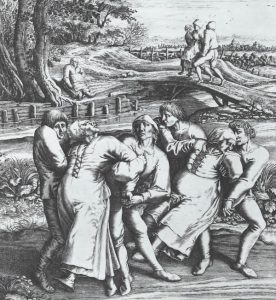By Emily G.
One of my favourite historical tidbits is the Dancing Plague of 1518. This is an event which occurred in Strasbourg, Alsace and lasted for a period of roughly a month.
In July of 1518, a woman named Frau Troffea began to dance - violently, and perhaps even ominously, without any sense of joy. Soon after, a neighbour joined her. Within a week, thirty odd people were dancing through the city in a frenzy, unable to stop. They danced on, throughout the night and into the morning, as if in a trance.
By the time a month had passed, up to 400 people were involved. Once some of the dancers begun dying of heart attacks, heat stroke and exhaustion, authorities were called in. Having ruled out supernatural causes, it was decided that the afflicted would be best off dancing the plague away, so a wooden stage was quickly built and musicians were hired to accompany the dancers. Historical documents make it very clear that the victims did indeed dance.
This may seem baffling, but there are many theories that have been put forward to explain this phenomenon. Some believe that these people were victims of mass hysteria, a mistaken belief that all involved are afflicted by an identical malady. This particular incident could have been brought on by stress, as it occurred during a time of devastating famine.
Others think this could be Ergotism, caused by the consumption of Rye that had been attacked by a specific kind of mold. To eat the mold can cause seizures, which could have been mistaken for (or combined with) movements traditionally associated with dance.
Finally, some have suggested that this was a religious phenomenon. However, no one theory can completely explain all the events that occurred.
The surviving dancers eventually stopped, and, as inexplicably as it began, the Dancing Plague was over.
Emily Greenwood


No comments:
Post a Comment